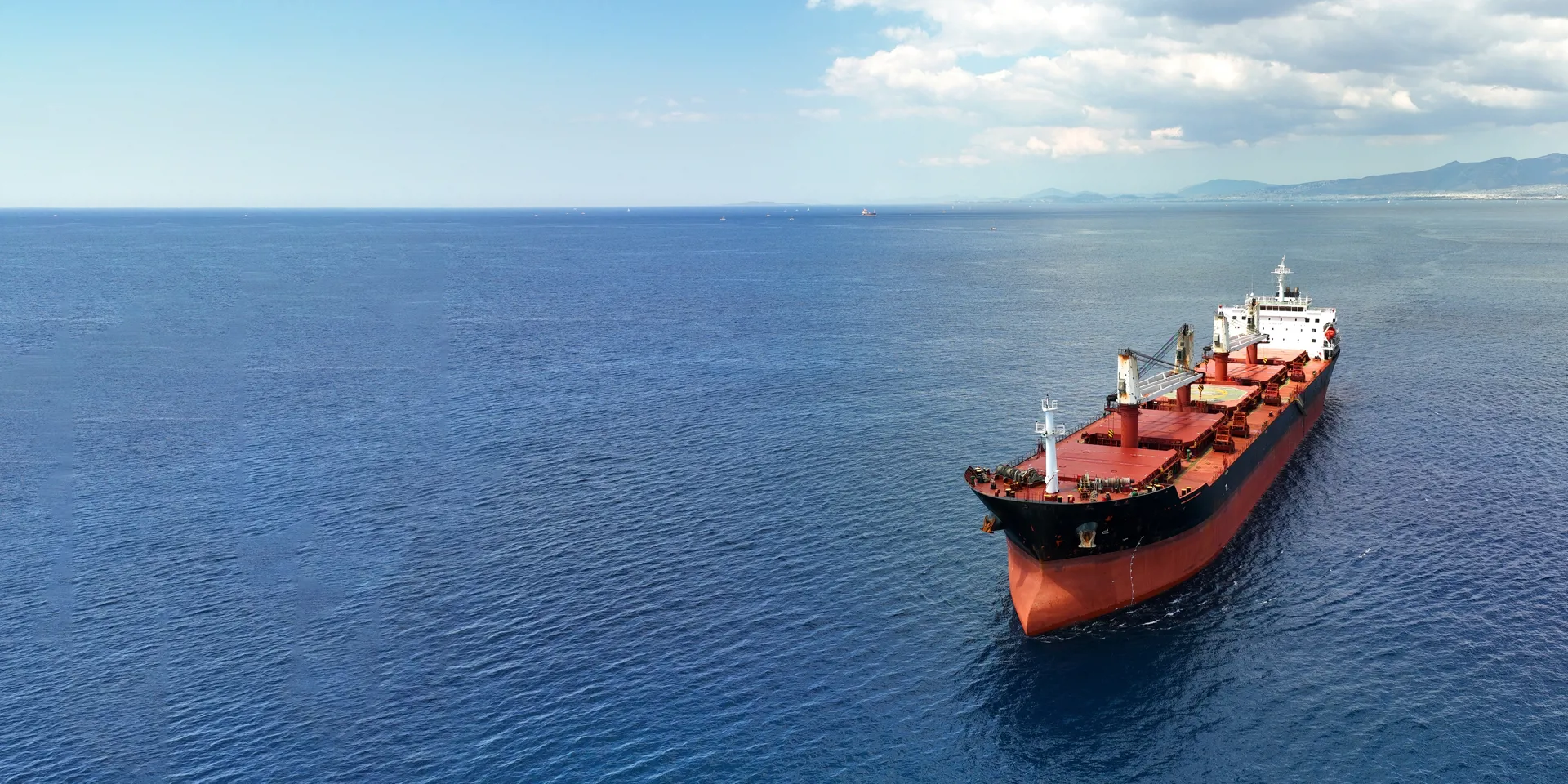Bulk carriers are a type of cargo ship. Unlike container ships, bulk vessels are specifically designed to carry large quantities of non-packaged cargo (e.g. coal, grain, and iron ore) over long distances. First developed in the 1950s, they are now a key part of today’s global commodities transport network, moving raw materials which support modern life (e.g. housing, heating, feeding populations, and manufacturing products).
There are approximately 5,000 bulk carriers in use around the world. These vessels can be identified by their distinctive structure: a long, flat deck, followed by an accommodation block with large hatchways that offer access to the cargo holds. In order to maintain the ship’s stability and prevent any damage to the cargo, there are hatch covers protecting the holds from water getting in.
Bulk vessels are also known to be one of the most environmentally friendly methods of transporting large volumes of dry cargo across long distances. A typical bulk carrier emits 6.5g CO2/tonne, which is significantly less than the average emissions of 61g CO2/tonne from rail transportation.
Panamax
The term ‘Panamax’ refers to a type of vessel which is of a size and specification specifically designed to pass through the Panama Canal. The maximum dimensions of Panamax vessels are set to ensure they can pass through the canal’s smallest lock. These are:
- Length: 294 metres (965 feet)
- Width: 3 metres (106 feet)
- Draft: 12 metres (39.5 feet)
- Capacity: 65,000 to 80,000 dwt
Typically, Panamax vessels carry iron ore, grain, and coal.
Aframax
Aframax vessels get their name from the Average Freight Rate Assessment (AFRA) system, designed by Shell Oil. Aframax ships are oil tankers with a capacity of under 120,000 deadweight tonnes with the following specifications:
- Length: 200 to 250 metres (656 to 820 feet)
- Width: 32 to 44 metres (105 to 144 feet)
- Draft: 12 to 16 metres (39 to 52 feet)
- Capacity: 80,000 to 120,000 dwt
Smaller than Suezmax tankers, their size means they can carry up to 750,000 barrels of crude oil, compared to the 2 million barrels that larger tankers can. As such, Aframax ships are better suited to short- and medium-haul routes to / from ports which do not have the infrastructure for larger vessels (e.g. from the North Sea or the Black Sea to Europe or the US.)
Suezmax
Suezmax vessels are a type of medium-sized oil tanker, which is bigger than an Aframax but smaller than a Very Large Crude Carrier (VLCC). In terms of specifications, Suezmax vessels typically measure:
- Length: 400 metres (1,300 feet)
- Width: 5 metres (254 feet)
- Draft: 1 metres (66 feet)
- Capacity: 160,000 dwt
They were given the name Suzemax because they are the largest type of vessel that is able to pass through the Suez Canal. You are most likely to find a Suezmax being used to transport crude oil on a long-haul route, however they can also be used to handle other ‘dirty’ products, such as fuel oil and bunker oil.
Handymax
Handymax ships are small-sized bulk carriers, which typically measure:
- Length: 150 to 200 metres (492 to 656 feet)
- Width: 30 to 32 metres (98 to 105 feet)
- Draft: 10 to 12 metres (33 to 39 feet)
- Capacity: 35,000 to 50,000 dwt
Due to their dimensions, Handymax ships are able to navigate various ports and waterways, including smaller ports and those without the infrastructure to handle larger vessels. This versatility makes them a popular choice for transporting a range of dry cargo, including iron ore, coal, cement, steel, fertiliser, and grain.
Capesize
Capesize ships are bulk carriers, typically used to transport coal, ore, and other raw commodities. There are also two subtypes of Capesize vessels - Very Large Ore Carriers (VLOC) and Very Large Bulk Carriers (VLBC) - which tend to be used to move iron ore. However, it is important to note that the term ‘Capesize’ is not used in relation to tankers. In terms of specifications, Capesize vessels measure approximately:
- Length: 290 metres (951 feet)
- Width: 45 metres (148 feet)
- Draft: 18 metres (59 feet)
- Capacity: 170,000 dwt
Their size makes them a more economical choice for transporting large quantities of raw materials over long distances. As one of the largest types of dry cargo ships, Capesize vessels are too big to use the Suez Canal or Panama Canal. When used for cross-Atlantic bulk trade, these ships therefore need to use routes which pass either via Cape Horn or the Cape of Good Hope - hence their name. Common routes for Capesize vessels include Brazil / Australia / South Africa to China, and South Africa to Europe.
Chinamax
Chinamax vessels get their name from their ability to move through the two main shipping routes between Asia and Europe (the Suez Canal and the Strait of Malacca). They were originally designed to transport goods between China and Brazil, however as more harbours have been developed with the infrastructure to handle Chinamax vessels, we are seeing their use expand to other routes and regions, including ports in Europe.
As some of the largest vessels ever built and the world’s largest type of bulk carrier, Chinamax vessels are typically categorised as Very Large Ore Carriers (VLOC). The approximate specifications of a Chinamax ship are:
- Length: 360 metres (1,181 feet)
- Width: 65 metres (213 feet)
- Draft: 25 metres (82 feet)
- Capacity: up to 400,000 dwt
Given their size, Chinamax vessels are crucial players in the maritime industry for transporting very large amounts of iron ore, coal, grain, and other raw materials. Importantly, despite their size, their design and advanced technology ensure they are efficient and environmentally friendly in terms of emissions and fuel consumption. Therefore, as global trade grows, we are seeing increased demand for Chinamax ships given their ability to move raw materials efficiently.

